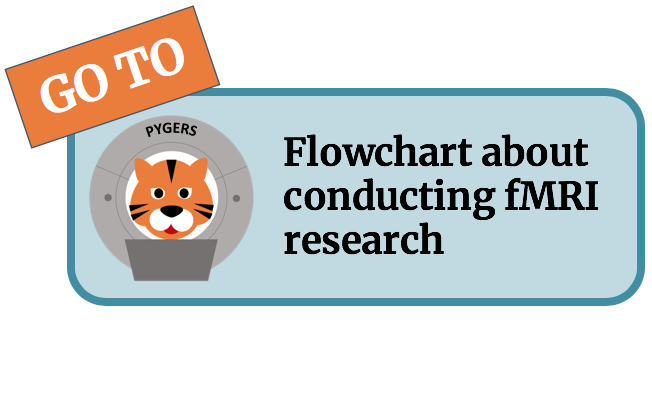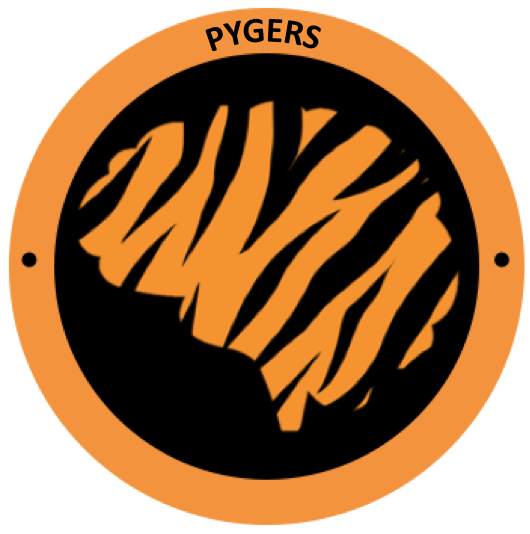Choosing your scanning acquisition parameters¶
Typical fMRI acquisitions include several types of images, including functional images, anatomical images, and field map images. In the following, we provide some recommendations about acquisition parameters, as well as naming conventions intended to facilitate data sharing.
Functional images¶
When setting up the sequence for a functional scan, there are several factors to take into consideration, including spatial resolution (voxel size in mm), temporal resolution (repetition time; TR), echo time (TE), number of slices (coverage), in-plane acceleration, multiband acceleration, flip angle, pixel bandwidth, and partial Fourier reconstruction. Most sequences require a compromise between these factors; not all combinations are feasible.
There are varying opinions on acquisition parameters, but we can make some very general recommendations. Consult the FAQ for additional details.
Spatial resolution: While larger voxels yield poorer spatial localization, reducing voxel size also reduces signal-to-noise ratio (SNR). On the other hand, smaller voxels may reduce susceptibility due to lower partial volume effects. Voxel sizes between 2 and 3 mm are typical for whole-brain functional imaging at 3T. However, smaller voxels (e.g., 1.5 mm) may be beneficial for applications requiring fine-grained spatial localization (e.g., hippocampal subfields).
Temporal resolution: Reducing the duration of the TR yields more samples and thus increases SNR (although this is ultimately limited by the smoothness of the hemodynamic signal). Typical TRs are 1.5 or 2.0 s, although shorter TRs are becoming more common.
Echo time: Shorter TE (e.g., < 30 ms) may be beneficial for experiments targeting brain areas susceptible to signal dropout (e.g., orbitofrontal cortex, medial temporal lobe). Typical TE ranges from 28–36 ms, and may be reduced by increasing pixel bandwidth.
Number of slices: The product of the voxel size (i.e., slice thickness) and number of slices determines the brain coverage; we recommend 120 mm to achieve whole-brain coverage on most subjects. When using multiband (SMS) acceleration, the number of slices must be a multiple of the multiband factor.
In-plane acceleration: The two main types of in-plane acceleration reduce acquisition time by acquiring within-slice data in parallel in either image space (mSENSE) or k-space (GRAPPA). GRAPPA may be used in conjunction with multislice acceleration, but may increase susceptibility to head motion and other artifacts.
Multiband acceleration: Multiband or simultaneous multislice (SMS) imaging reduces acquisition time by acquiring multiple slices simultaneously; for example, SMS 4 will acquire four slices simultaneously. Large multiband acceleration factors can increase artifacts; we recommend using SMS 2–4.
Flip angle: Flip angle should be optimized to the Ernst angle (http://www.mritoolbox.com/ErnstAngle.html) based on the TR and a T1 recovery rate of ~1500 ms (http://www.mritoolbox.com/ParameterDatabase.html).
Bandwidth: We recommend using a pixel bandwidth 1500–2500 Hz; higher bandwidth results in poorer spatial specificity.
Partial Fourier reconstruction: Subsampling k-space during reconstruction can accelerate acquisition, but may reduce spatial specificity.
Reference sequences¶
For Siemens Skyra and Prisma, PNI provides several reference sequences:
Skyra¶
3.0 mm voxels, TR = 1.5, TE = 30, SMS = 2, 42 slices (126 mm)
2.5 mm voxels, TR = 2.0, TE = 30, SMS = 2, 50 slices (125 mm)
2.5 mm voxels, TR = 1.5, TE = 30, SMS = 3, 51 slices (127.5 mm)
2.5 mm voxels, TR = 1.0, TE = 30, SMS = 4, 44 slices (110 mm)
2.0 mm voxels, TR = 1.5, TE = 30, SMS = 3, PF = 6/8, 51 slices (102 mm)
2.0 mm voxels, TR = 1.0, TE = 30, SMS = 5, PF = 6/8, 55 slices (110 mm)
1.5 mm voxels, TR = 2.0, TE = 41, SMS = 5, PF = 6/8, 75 slices (112.5 mm)
Prisma¶
3.0 mm voxels, TR = 1.5, TE = 30, SMS = 2, 42 slices (126 mm)
2.5 mm voxels, TR = 2.0, TE = 30, SMS = 2, 54 slices (135 mm)
2.5 mm voxels, TR = 1.5, TE = 30, SMS = 3, 63 slices (157.4 mm)
2.5 mm voxels, TR = 1.0, TE = 30, SMS = 4, 52 slices (130 mm)
2.0 mm voxels, TR = 1.5, TE = 30, SMS = 3, PF = 7/8, 57 slices (114 mm)
2.0 mm voxels, TR = 1.0, TE = 30, SMS = 4, PF = 7/8, 52 slices (104 mm)
1.5 mm voxels, TR = 2.0, TE = 30, SMS = 4, PF = 6/8, 84 slices (126 mm)
Anatomical images¶
Typical fMRI analyses require a T1-weighted structural image for spatial alignment. We use FreeSurfer’s recommended multi-echo sequence with 1 mm isotropic voxels with a GRAPPA acceleration factor of 2 (~6 minute duration; FreeSurfer Protocol). You may also collect a T2-weighted structural image, which can provide better contrast for differentiating subcortical structures (~5 minute duration). Other analysis pipelines may require specific structural images. For example, if you want to use the ASHS toolbox for automatic segmentation of hippocampal subfields, or even if you want to do manual segmentations of hippocampal subfields, you will need an oblique coronal T2-weighted turbo spin echo (TSE) acquisition with high in-plane resolution (0.4 mm).
Field map images¶
Functional images are distorted by magnetic field inhomogeneities near the sinuses. Field map images can be used to recover displaced signal, a process called susceptibility distortion correction (SDC). There are several methods of SDC (which rely on different types of field map acquisitions):
Phase encoding polarity (PEPOLAR) correction: This method uses two spin echo acquisitions with opposite phase encoding directions (anterior-to-posterior and posterior-to-anterior; also known as blip-up/blip-down).
Phase-difference B0 correction: This method uses the difference in phase between two echoes in single acquisition (double- or dual-echo field map).
Fieldmap-less correction: This method uses nonlinear registration to perform SDC based on an average field map atlas (and does not require a field map acquisition).
References for more information¶
Deichmann, R., Gottfried, J. A., Hutton, C., & Turner, R. (2003). Optimized EPI for fMRI studies of the orbitofrontal cortex. NeuroImage, 19(2), 430-441. https://doi.org/10.1016/S1053-8119(03)00073-9
Demetriou, L., Kowalczyk, O. S., Tyson, G., Bello, T., Newbould, R. D., & Wall, M. B. (2018). A comprehensive evaluation of increasing temporal resolution with multiband-accelerated protocols and effects on statistical outcome measures in fMRI. NeuroImage, 176, 404–416. https://doi.org/10.1016/j.neuroimage.2018.05.011
Gardumi, A., Ivanov, D., Hausfeld, L., Valente, G., Formisano, E., & Uludağ, K. (2016). The effect of spatial resolution on decoding accuracy in fMRI multivariate pattern analysis. NeuroImage, 132, 32–42. https://doi.org/10.1016/j.neuroimage.2016.02.033
Sengupta, A., Yakupov, R., Speck, O., Pollmann, S., & Hanke, M. (2017). The effect of acquisition resolution on orientation decoding from V1 BOLD fMRI at 7 T. NeuroImage, 148,64–76. https://doi.org/10.1016/j.neuroimage.2016.12.040
Mandelkow, H., de Zwart, J. A., & Duyn, J. H. (2017). Effects of spatial fMRI resolution on the classification of naturalistic movies. NeuroImage, 162, 45–55. https://doi.org/10.1016/j.neuroimage.2017.08.053
Weiskopf, N., Hutton, C., Josephs, O., Turner, R., & Deichmann, R. (2007). Optimized EPI for fMRI studies of the orbitofrontal cortex: compensation of susceptibility-induced gradients in the readout direction. Magnetic Resonance Materials in Physics, Biology and Medicine, 20(1), 39. https://doi.org/10.1007/s10334-006-0067-6
Welvaert, M., & Rosseel, Y. (2013). On the definition of signal-to-noise ratio and contrast-to-noise ratio for fMRI data. PLOS ONE, 8(11), e77089. https://doi.org/10.1371/journal.pone.0077089
Resources¶
practiCAL fMRI, “Comparing fMRI Protocols” https://practicalfmri.blogspot.com/2011/01/comparing-fmri-protocols.html

